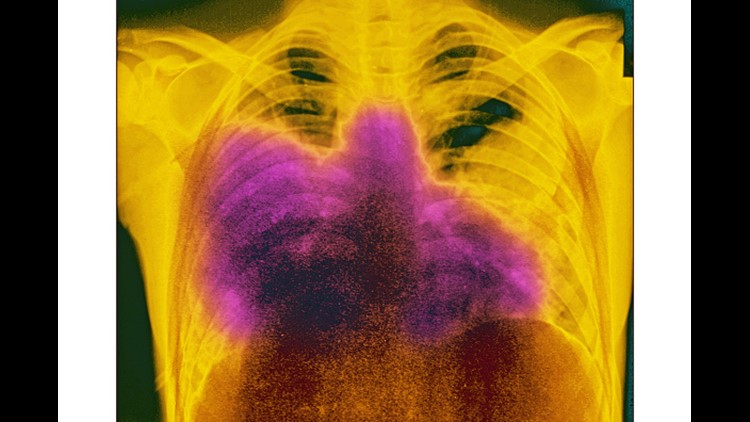Legionnaires’ disease, a deadly but preventable form of pneumonia caused by the Legionella bacteria, is showing up in numerous healthcare facilities across the country via their water supplies, according to the Centers for Disease Control and Prevention.
Infection rates tend to be highest during the summer months and in the mid-Atlantic region, according to a June commentary published in the journal JAMA Network Open. And while rates of diagnosed Legionnaires' disease climbed between 2014 and 2016, it remains uncommon in the general population, according to a Veterans Administration (VA) report that looked at infection rates among veterans.
Cases are still a concern, however, because long-term-care facilities and hospitals are among the most common places people catch the disease, according to the CDC. And people who are older (over 50) and sicker (former smokers and people with compromised immune systems, for example) are more susceptible to the infection.
Of the 21 jurisdictions the researchers analyzed for a 2017 CDC report (20 states plus New York City), 16 had at least some cases that were clearly hospital-acquired. (The researchers focused on reported cases for a single year, 2015.) That was the first time the CDC analyzed the portion of Legionnaires’ disease cases (which have been on the rise nationwide in recent years) that come from healthcare facilities.
The findings from the VA and the CDC underscore the need for hospitals and nursing homes to manage their water systems better. They also represent an important note for doctors and patients: Not all respiratory infections are created equal. Underdiagnosis is rampant, according to the VA study, and Legionnaires’ is often mistaken for less virulent forms of pneumonia. But simple diagnostic tests can help tell the two apart and potentially save lives as a result.
“It’s a good reminder for consumers,” says Anne Schuchat, M.D., the principal deputy director of the CDC. “We know that those tests aren’t as widely used as they might be.”
What Is Legionnaires' Disease?
Legionnaires’ disease is a bacterial infection usually contracted by inhaling droplets of contaminated water. The droplets can come from showerheads, water-therapy spas and baths, cooling towers, and some medical equipment. The signs of infection (coughing, shortness of breath, fever, muscle aches, and headaches) are common enough to be mistaken for regular pneumonia, but Legionnaires’ disease is far more deadly.
Although most healthy people who are exposed to Legionella bacteria don’t go on to develop the disease, 10 percent of those who do get sick die. That death toll increases to 25 percent in hospitals because people who have compromised lungs or immune systems are more vulnerable to the disease.
How Widespread Is the Problem?
Legionnaires’ disease is relatively rare: About 6,000 cases are reported each year compared with hundreds of thousands for other more common forms of pneumonia.
But the CDC says the incidence is rising significantly. Between 2000 and 2015, the agency logged a 4.5-fold increase in reported cases of the infection. Part of that increase is the result of better diagnostic tests and better monitoring by hospitals, but some of it reflects a legitimate increase in the number of cases.
Schuchat and others suspect that aging hospital infrastructure may be playing a role in the uptick. “When you look at a typical hospital or typical healthcare facility, they’ve been expanded and renovated and added onto, and their original plumbing is hard to even figure out,” she says. “It does put us at risk for more Legionnaires’ disease being picked up in hospitals.”
Overall, the CDC suspects that the incidence of Legionnaires’ disease is even greater than the numbers suggest. The available diagnostic tests can’t detect every type of Legionella bacteria, and even people who are hospitalized with very severe pneumonia may not receive those tests to begin with. “Pneumonia is extremely common, and many people are treated without any diagnostic tests being run at all,” Schuchat says.
What Are Hospitals Doing About It?
According to previous research (also by the CDC), 80 percent of all Legionnaires’ disease outbreaks—both in and out of healthcare facilities—could be prevented with better water-management programs.
Last year the CDC created a tool kit to help healthcare facilities establish and run such programs. The agency doesn't know yet how extensively the tools are being employed, but Cynthia Whitney, M.D., chief of respiratory diseases at the CDC, says it has been an uphill battle getting infection-control experts to address water quality.
“This is a big cultural change for hospitals,” she says. “We’ve had tremendous improvement in antibiotic control and in the management of other hospital-acquired infections through hand-washing and other checklist kinds of processes. But most infection-control practitioners haven’t even heard that Legionella can be an issue.”
That may soon change. Last year the Centers for Medicare & Medicaid Services issued a statement declaring that going forward, healthcare facilities will be held accountable for their water-management strategies or lack thereof. “It’s a warning to healthcare facilities,” Whitney says. “If you don’t have a water-management plan, now is a good time to develop one.”
How Can You Protect Yourself?
In the meantime, the bottom line for consumers is a bit simpler.
You might not be able to do anything about your hospital’s water supply, but you can still take some steps to protect yourself. If you or someone you love is diagnosed with pneumonia in a hospital or another healthcare facility (or in the weeks after being discharged from a facility) ask for a Legionnaires’ disease test. (There are two tests that clinicians use for this; one relies on urine samples, the other on phlegm.)
The available tests won’t detect every possible strain of this infection. But they may detect the more common and virulent versions. And if you test positive, they will help your doctor tailor your treatment at the outset. Despite the alarming fatality rates, most cases of Legionnaires’ disease can be treated successfully with the right antibiotics.



